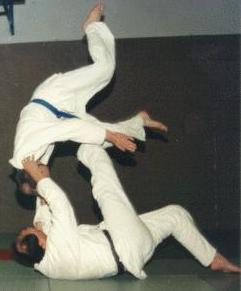 W
WIn martial arts, a throw is a grappling technique that involves off-balancing or lifting an opponent, and throwing them to the ground, in Japanese martial arts referred to as nage-waza, 投げ技, "throwing technique". Throws are a subset of takedown (grappling). Certain throwing techniques called sacrifice throws involve putting oneself in a potentially disadvantageous position, such as on the ground, in order to execute a throw.
 W
WAshi guruma is a throw in judo. It is one of the original 40 throws of Judo as developed by Kano Jigoro. It belongs to the third group of the traditional throwing list in the Gokyo no waza of the Kodokan Judo. It is also included in the current 67 Throws of Kodokan Judo and is classified as a foot technique (ashiwaza).
 W
WDaki Age (抱上) is a throw in judo. It is one of the techniques adopted later by the Kodokan into the Shinmeisho No Waza list. It is categorized as a hip technique, Koshi-waza. In practice it is very similar to a body slam, the object being for tori to lift uke while in his guard subsequently forcefully dropping uke onto their back. This is a very dangerous technique that has the potential to cause spinal injuries. Generally uke will release their guard if they cannot prevent the lift.
 W
WDeashi Harai (出足払), more accurately romanized: Deashibarai, is one of the original 40 throws of Judo as developed by Jigoro Kano. It belongs to the first group, Dai-Ikkyo, of the traditional throwing list, Gokyo-no-Nagewaza, of Kodokan Judo. It is also part of the current 67 Throws of Kodokan Judo. It is classified as a foot technique, Ashi-Waza. Deashi Harai is also one of the 20 techniques in Danzan Ryu's (DZR) Nagete list.
 W
WHane goshi is a throw in judo. It is one of the original 40 throws of Judo as developed by Jigoro Kano. It belongs to the third group, Sankyo, of the traditional throwing list, Gokyo, of Kodokan Judo. It is also part of the current 67 Throws of Kodokan Judo. It is classified as a hip technique, Koshi-Waza. Hane goshi is also one of the 20 techniques in Danzan Ryu's Nagete list.
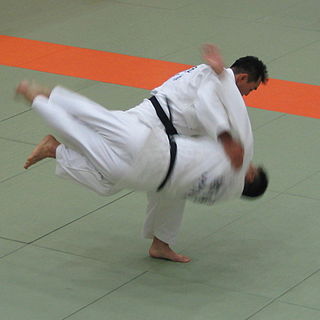 W
WHarai goshi (払腰) is one of the original 40 throws of Judo as developed by Kano Jigoro. It belongs to the second group of the traditional throwing list in the Gokyo no waza of the Kodokan Judo. It is also part of the current 67 Throws of Kodokan Judo, and classified as a hip technique (koshiwaza). Harai goshi is also one of the 20 techniques in Danzan ryu's Nagete list as well as one of the 18 throws in the Kar-do-Jitsu-Ryu martial arts system. English terms include "Sweeping hip throw" and "Hip Sweep".
 W
WHarai Tsurikomi Ashi (払釣込足) is one of the original 40 throws of Judo as developed by Jigoro Kano. It belongs to the third group, Sankyo, of the traditional throwing list, Gokyo, of Kodokan Judo. It is also part of the current 67 Throws of Kodokan Judo. It is classified as a foot technique, Ashi-waza.
 W
WHiza guruma (膝車) is one of the original 40 throws of Judo as developed by Kano Jigoro. It belongs to the first group of the traditional throwing list in the Gokyo no waza of the Kodokan Judo. It is also included in the current 67 throws of Kodokan Judo. It is classified as a foot technique (ashiwaza).
 W
WThe ippon seoi nage (一本背負投) is a throw in judo. It is a variant of Seoi nage, and is one of the nineteen accepted techniques in Shinmeisho No Waza of Kodokan Judo. It is classified as a hand throwing technique, or te-waza.
 W
WKata guruma (肩車) is one of the traditional forty throws of judo as developed by Kano Jigoro. Kata guruma belongs to the third group of the traditional throwing list in the Gokyo no waza of the Kodokan Judo. It is also part of the current 67 Throws of Kodokan Judo. Because the technique is not a sweep nor a trip and requires tori to pull uke into a carry, it is categorized as a hand throwing technique (tewaza).
 W
WKoshi Guruma (腰車), is one of the original 40 throws of Judo as developed by Jigoro Kano. It belongs to the second group,
 W
WKosoto Gake (小外掛), sometimes known as "minor outer hook", the English translation, is one of the original 40 throws of Judo as developed by Jigoro Kano. It belongs to the third group, Sankyo, of the traditional throwing list, Gokyo, of Kodokan Judo. It is also part of the current 67 Throws of Kodokan Judo. It is classified as a foot technique, Ashi-waza. It is often used as a counter-throw to tai-otoshi, after having stepped over the leg. To perform the technique, the tori grabs uke using one of several compatible grips - the traditional example being the sleeve collar grip. He then steps forwards diagonally to place all of uke's weight on the foot tori wishes to reap. This leg is reaped by wrapping the leg around his leg from the outside and plucking the ankle or calf upward with the back of tori's own ankle or calf respectively. Because the weight was planted on this foot due to off-balancing uke, tori can make him fall. If uke's weight is not on the leg being swept, uke will remain stable and be able to keep his balance. This should all be done in a fluid motion so that uke's weight is moving backwards whilst the leg is being reaped, otherwise it will be too heavy to lift although the throw can still work sometimes from this position.
 W
WKosoto Gari (小外刈), is one of the original 40 throws of Judo as developed by Jigoro Kano. It belongs to the second group, Dai Nikyo, of the traditional throwing list, Gokyo, of Kodokan Judo. It is also part of the current 67 Throws of Kodokan Judo. It is classified as a foot technique, Ashi-waza. Danzan-ryū's Soto Gama is a variant of Kosoto Gari.
 W
WKouchi Gari (小内刈) is one of the original 40 throws of judo as developed by Jigoro Kano. It belongs to the second group, Dai Nikyo, of the traditional throwing list, Gokyo, of Kodokan judo. It is also part of the current 67 throws of Kodokan judo. It is classified as a foot technique, ashi-waza.
 W
WŌ goshi is one of the original 40 throws of Judo as compiled by Jigoro Kano.
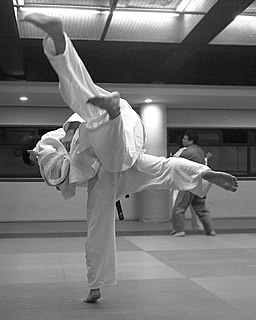 W
WŌ guruma (大車) is one of the original 40 throws of Judo as developed by Kanō Jigorō. It belongs to the fourth group of the traditional throwing list in the Gokyo no waza of the Kodokan Judo. It is also part of the current 67 Throws of Kodokan Judo. It is classified as a foot technique (ashiwaza).
 W
WObi Otoshi (帯落) is one of the preserved throwing techniques, or Habukareta Waza, of Judo. the 1895 Gokyo no Waza lists. A related technique with the same name is also on the Shinyo no Maki list of Danzan Ryu Jujutsu. It is categorized as a hand technique, Te-waza.
 W
WOkuriashi harai (送足払) is one of the original 40 throws of Judo as developed by Kano Jigoro. It belongs to the second group of the traditional throwing list in the Gokyo no waza of the Kodokan Judo. It is also part of the current 67 Throws of Kodokan Judo. It is classified as a foot technique (ashiwaza).
 W
WOsoto Guruma (大外車), is one of the original 40 throws of Judo as developed by Jigoro Kano. It belongs to the fifth group,
 W
WOsoto Otoshi (大外落) is one of the preserved throwing techniques, Habukareta Waza, of Judo. It belonged to the fourth group, Yonkyo, of the 1895 Gokyo no Waza lists. It is categorized as a foot technique, Ashi-waza.
 W
WOsotogari (大外刈) is one of the original 40 throws of Judo as developed by Jigoro Kano. It belongs to the first group, Dai Ikkyo, of the traditional throwing list, Gokyo, of Kodokan Judo. It is also included in the current 67 Throws of Kodokan Judo. It is classified as a foot technique, Ashi-Waza.
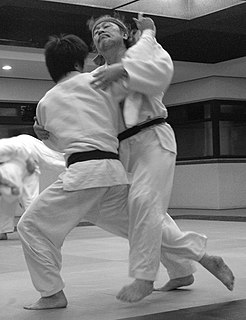 W
WŌuchi gari (大内刈) is one of the original 40 throws of Judo as developed by Kanō Jigorō. It belongs to the first group, Dai Ikkyo, of the traditional throwing list, Gokyo, of Kodokan Judo. It is also included in the current 67 Throws of Kodokan Judo.It is classified as a foot technique, Ashi-Waza.
 W
WSasae Tsurikomi Ashi (支釣込足) is one of the traditional forty throws of Judo as developed by Jigoro Kano. Sasae Tsurikomi Ashi belongs to the first group, Dai Ikkyo, of the traditional throwing list, Gokyo, of Kodokan Judo. It is also part of the current 67 Throws of Kodokan Judo. It is classified as a foot technique, Ashi-Waza.
 W
WSeoi nage (背負投) is a shoulder throw, one of the traditional forty throws of Judo as developed by Jigoro Kano. It belongs to the first group, Dai Ikkyo, of the traditional throwing list, Gokyo, of Kodokan Judo. It is also part of the current 67 Throws of Kodokan Judo. It is classified as a hand technique, te-waza, and is the second throw performed in the Nage-no-kata.
 W
WSode Tsurikomi Goshi (袖釣込腰) is a Judo throw and one of the techniques adopted by the Kodokan into their Shinmeisho No Waza list. It is categorized as a hip technique, or Koshi-waza. Sode Tsurikomi Goshi translates as sleeve lifting pulling hip throw.
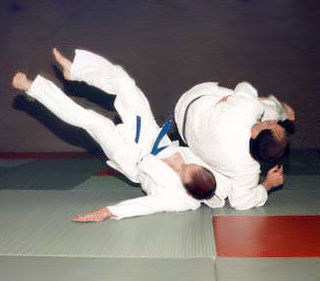 W
WSoto Makikomi (外巻込) is one of the traditional forty throws of Judo as developed by Jigoro Kano. It belongs to the fourth group, Yonkyo, of the traditional throwing list, Gokyo, of Kodokan Judo. It is also part of the current 67 Throws of Kodokan Judo. Because tori takes a side fall next to uke, the technique is categorized as a side sacrifice technique, Yoku-sutemi. Danzan Ryu's Makikomi (巻込) is also one of the twenty throws in the Nagete list, which most closely resembles Soto Makikomi.
 W
WSukui Nage (掬い投) is a double leg takedown, one of the original 40 throws of Judo as developed by Jigoro Kano. It belongs to the fourth group, Yonkyo, of the traditional throwing list, Gokyo, of Kodokan Judo. It is also part of the current 67 Throws of Kodokan Judo. It is classified as a hand technique, Te-waza.
 W
WSumi Gaeshi (隅返) is one of the original 40 throws of Judo as developed by Jigoro Kano. It belongs to the fourth group,
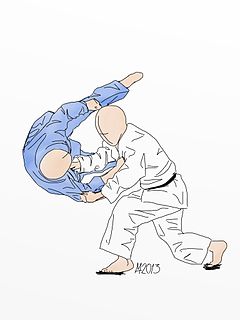 W
WSumi Otoshi (隅落), is one of the original 40 throws of Judo as developed by Jigoro Kano. It belongs to the fifth group, Gokyo, of the traditional throwing list, Gokyo, of Kodokan Judo. It is also part of the current 67 Throws of Kodokan Judo. It is classified as a hand technique, Te-waza.
 W
WTai Otoshi (体落), is one of the original 40 throws of Judo as developed by Jigoro Kano.
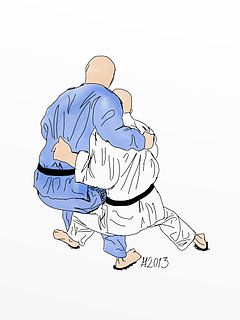 W
WTani otoshi (谷落) is one of the original 40 throws of Judo as developed by Kano Jigoro. It belongs to the fourth group of the traditional throwing list in the Gokyo no waza of the Kodokan Judo. It is also part of the current 67 Throws of Kodokan Judo. It is classified as a side sacrifice technique (yoko-sutemi).
 W
WTomoe nage (巴投) is one of the traditional forty throws of jujutsu and Judo. It belongs to the third group (Sankyo) of the traditional throwing list, the traditional Gokyo, and the current 67 Throws of Kodokan Judo.
 W
WTsuri goshi (釣腰) is one of the original 40 throws of Judo as developed by Kano Jigoro. It belongs to the third group of the traditional throwing list in the Gokyo no waza of the Kodokan Judo. It is also part of the current 67 Throws of Kodokan Judo. It is classified as a hip technique (koshiwaza).
 W
WTsurikomi Goshi (釣込腰), is one of the original 40 throws of Judo as developed by Jigoro Kano. It belongs to the second group, Dai Nikyo, of the traditional throwing list, Gokyo, of Kodokan Judo. It is also part of the current 67 Throws of Kodokan Judo. It is classified as a hip throwing technique, Koshi-Waza. Tsurikomi Goshi is also one of the 20 techniques in Danzan Ryu's Nage No Te list.
 W
WUchi mata (内股) is one of the original 40 throws of Judo as developed by Kanō Jigorō. It belongs to the second group, Dai Nikyo, of the traditional throwing list, Gokyo, of Kodokan Judo. It is also part of the current 67 Throws of Kodokan Judo. It is classified as a foot technique, Ashi-Waza. A counter to uchi mata is uchi mata sukashi as well as Te Guruma. To this day uchi mata has consistently been one of the highest scoring techniques in competition.
 W
WUki Goshi (浮腰) is one of the original 40 throws of Judo as developed by Jigoro Kano. It belongs to the first group, Dai Ikkyo, of the traditional throwing list, Gokyo, of Kodokan Judo. It is also part of the current 67 Throws of Kodokan Judo. It is classified as a hip technique, Koshi-Waza. Uki goshi is known as a favorite throw of Jigoro Kano himself. It is demonstrated in the Nage no Kata. It used to be much drilled in traditional judo dojos.
 W
WUki otoshi (浮落), or "floating drop," is one of the traditional forty throws of Judo as developed by Jigoro Kano. It belongs to the fourth group, Dai Yonkyo, of the traditional throwing list, Gokyo-no-Nagewaza, of Kodokan Judo. It is also part of the current 67 Throws of Kodokan Judo. The technique is categorized as a hand technique, Te-waza.
 W
WUra Nage (裏投) is one of the original 40 throws of Judo as developed by Jigoro Kano. It belongs to the fifth group, Gokyo, of the traditional throwing list, Gokyo, of Kodokan Judo. It is also part of the current 67 Throws of Kodokan Judo. It is classified as a rear sacrifice technique, Ma-sutemi.
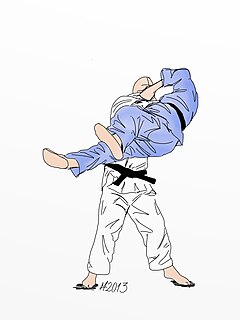 W
WUshiro Goshi (後腰), is one of the original 40 throws of Judo as developed by Jigoro Kano. It belongs to the fifth group, Gokyo, of the traditional throwing list, Gokyo-no-Nagewaza, of Kodokan Judo. It is also part of the current 67 Throws of Kodokan Judo.
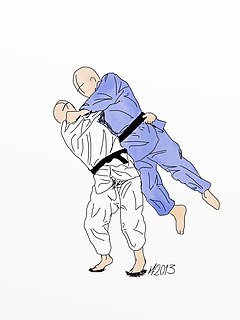 W
WUtsuri Goshi (移腰), or the changing hip throw, is one of the original 40 throws of Judo as developed by Jigoro Kano. It belongs to the fourth group, Yonkyo, of the traditional throwing list, Gokyo-no-Nagewaza, of Kodokan Judo. It is also part of the current 67 Throws of Kodokan Judo. It is classified as a hip technique, Koshi-Waza.
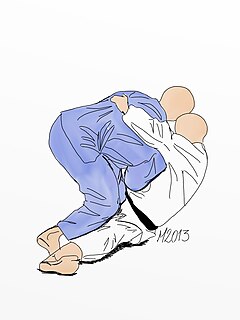 W
WYoko Otoshi (横落) is one of the original 40 throws of Judo as developed by Jigoro Kano. It belongs to the third group,